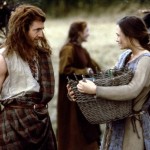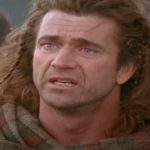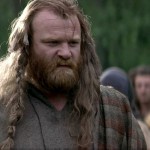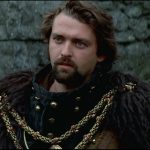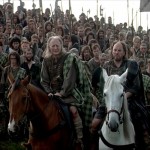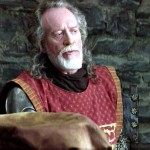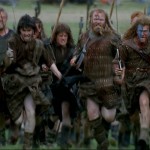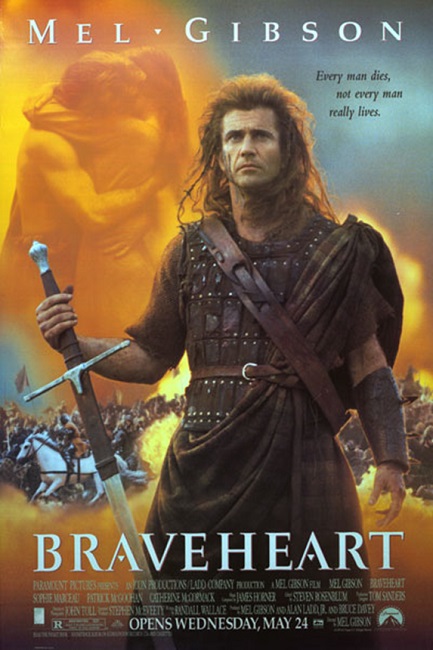
Braveheart – 1995
Another great movie! I went into this one having seen it before a few times, so I already knew the story. The plot is one on a very grand scale. The film stars Mel Gibson, Sophie Marceau, Patrick McGoohan, Catherine McCormack, Angus MacFadyen, and Brendan Gleeson. Actually those actors just make up the main cast. There were about a dozen other actors making up the supporting cast, and about 1,600 extras, most of whom were members of the Irish Army Reserve.
Interesting note: To save money on the production, Gibson used his Irish extras to play both the English and Scottish armies. The extras had to be given permission to grow beards and exchange their drab uniforms for medieval garb.
Now, I’ll admit right from the very beginning, in my research, I found that Braveheart was… nowhere near historically accurate. In fact, the very title of the film is misleading. It is clearly referring to the character played my Mel Gibson, but in reality, the name Braveheart refers to Robert the Bruce. Still, I didn’t think this made it a bad movie, just a fictional one. It was still highly entertaining and exciting to watch. Just throw the historical accuracy out the window and enjoy the action. But I’ll get to a few of the glaring examples in a bit.
Mel Gibson did a pretty good job as the character of William Wallace, historical inaccuracies aside – not great but not bad at all. His Scottish accent was a little inconsistent, but that is fairly easy to forgive. Scottish is one difficult accent to fake. Gibson looked alright with long hair and pulled off the kilt without a problem. He was even fit enough to lose his shirt every now and then.
If I had any real complaints about his performance, it would be that there was very little subtlety. All emotional content was very much on his sleeve. There were several scenes in which I believe he could have dug a little deeper in himself and pulled up a stronger performance: specifically, all the scenes after the death of his wife Murran, played by Catherine McCormack, in which he thinks of her, dreams of her, or speaks of her.
Other cast members who stood out to me were Angus Macfadyen, Sophie Marceau, and Brendan Gleason. Macfadyen played Robert the Bruce, the rightful heir to the throne of Scotland. He had a heart that was in the right place, though he was caught switching sides between that of his Scottish countrymen and England. He was too obedient to his father, who encouraged him to be self serving, even to the point of betraying Wallace. It was actually a pretty complex role to play and Macfadyen did it pretty well.
Marceau played Princess Isabella of France. This was a simple role in that the emotions of the character, as she is married off to a man who did not love her and used as a pawn in the political schemes of the King Edward “Longshanks”, needed a more subtle approach. Marceau did a good job of holding those emotions beneath the surface, even though she became very passionate about the events that were unfolding. The rare moment when she was allowed to lose control and take Wallace into her bed was also well played.
Then we come to Gleason, playing the part of Hamish, Wallace’s best friend. He was a big and burly man, a great fighter, and a fiercely loyal friend. He could have easily been a pretty one-dimensional character, but Gleason made him stand out to me. There was even a scene when his father died where he was able to display some real and convincing emotions. His quiet sobbing brought me to tears as well.
And finally, I have to mention another actor who, while we are not supposed to like him, did a great job. Peter Hanly played the part of Longshanks’ son, Prince Edward II. The character was portrayed as a homosexual and a weak, whimpering brat. Hanly was actually very believable in his portrayal. It was not too over the top and he made me dislike the character just enough to be believable.
Now, there was some controversy surrounding his character and his gay lover Phillip, played by Stephen Billington. It has become pretty common knowledge that Mel Gibson, the film’s producer, director, and lead actor, is very anti-gay. There is a scene in which Phillip is murdered by the King and the film received criticism because of the gratuitous death of a gay character. But I think those critics missed the point. First, historically, homosexuals have never been looked on in a favorable light, and for a prince who would one day sit on the throne of England to have a gay lover that clearly influenced him in his political dealings, it must have been a nasty thorn in the King’s side. If you’ll notice, the King actually tolerated him as long as he stayed in the background. But when he, a veritable nobody when it came to the monarchy, its politics and its military campaigns, began to usurp more power than he was due, the psychopathic King simply removed him in a swift and unapologetic manner. The fact that he was gay was not the main reason for the murder.
Gibson expressed bewilderment by audience reactions of laughter when it happened. I think I can explain that a little, He was made out to be such a smarmy and smug character that I was glad when he was taken out of the picture. It was the quick and impulsive manner in which it happened that was amusing.
Now, the cinematography, as you might imagine for a movie that takes place in the beautiful country of Scotland, was pretty spectacular. Scotland is actually a very small island, but it has, in my opinion, some of the most gorgeous and lush natural scenery in the world. Gibson and cinematographer John Toll really took advantage of the beauty of the Scottish countryside.
And it was also, during those scenes that showed the wonders of the Scottish landscapes, that the volume of the music of James Horner was really turned up. The soundtrack, as you might imagine, was as gorgeous and lush as the scenery. It was designed to be uplifting and inspirational as we follow the legendary Wallace on his path to greatness. Of course, bagpipes were often used to wonderful effect, lending a distinctly Scottish flavor to the music.
The film starts out when William Wallace is a peasant child and he begins to see the evils perpetrated against the Scotts by King Edward Longshanks, who lures the Scottish Nobles to a meeting under a flag of truce and murders them all, leaving their bodies on display in a public place. Within that sentence lies the first several of the movies many inaccuracies.
First of all, King Edward I was not as evil as he is depicted in the film. Specifically, the murder of the Scottish Nobles never happened. That was made-up. Second, Wallace was not a peasant. He was born into the gentry of Scotland. And it just keeps getting worse from there. I think that some of the most amusing and glaring fallacies in the film can be summed up by this hefty quote I have lifted directly from Wikipedia:
“Sharon Krossa notes that the film contains numerous historical errors, beginning with the wearing of belted plaid by Wallace and his men. In that period ‘no Scots … wore belted plaids (let alone kilts of any kind).’ Moreover, when Highlanders finally did begin wearing the belted plaid, it was not ‘in the rather bizarre style depicted in the film.’ She compares the inaccuracy to ‘a film about Colonial America showing the colonial men wearing 20th century business suits, but with the jackets worn back-to-front instead of the right way around.’ ‘The events aren’t accurate, the dates aren’t accurate, the characters aren’t accurate, the names aren’t accurate, the clothes aren’t accurate—in short, just about nothing is accurate.’ The belted plaid was not introduced until the 16th century. Peter Traquair has referred to Wallace’s ‘farcical representation as a wild and hairy highlander painted with woad (the blue face paint) 1,000 years too late, running amok in a tartan kilt 500 years too early.’”
Interesting note: Wallace’s affair with Princess Isabella of France? Never happened. In actuality, Isabella was three years old and living in France at the time, was not married to Edward II until he was already king and Edward III was born seven years after Wallace died.
nother Interesting note: When asked by a local why the Battle of Stirling Bridge was filmed on an open plain, Gibson answered that “the bridge got in the way“. “Aye,” the local answered. “That’s what the English found.”
So how can a movie that was based on historical events, but got so few of them right win the Academy Award for Best Picture. Braveheart has been described on numerous occasions and by several sources as one of the most historically inaccurate movies of all time.
I think I can sum that up pretty easily. This is Hollywood, my friends! It did not win for Best Documentary. It won for Best Picture. In this rare instance, I’m OK with making things up as long as it is entertaining to watch. Mel Gibson actually acknowledged many of the inaccuracies and defended his film, saying that the way events were portrayed in the film was much more “cinematically compelling” than historical fact.
In other words, the fictional story told on the big screen was more dramatic than reality. And the film’s drama was certainly compelling. The action sequences were exciting to watch, the characters’ motivations were believable and the movie’s pace made it all quite engaging. Gibson gave audiences what they wanted to see.
Making Wallace a peasant automatically makes him a common man like most of us, and an underdog to boot. Turning his crusade into a mission of revenge for a murdered wife, which actually had a small amount of truth in it, gave the hero an understandable justification for all the bloodshed for which he was responsible. It also had the benefit of throwing a bit of romantic motivation into the character.
In short, whatever Gibson did with historical truth, he made a good movie with a gripping story line and audiences ate it up. The film won 5 of the 10 Academy Awards it was nominated for. In addition to Best Picture, Braveheart won for Best Director (Gibson), Best Cinematography, Best Makeup, and Best Sound Editing.
But I guess if you want the real story of William Wallace, you’ll have to do your own research. As long as you keep in mind that the film is historical fiction, you should be able to enjoy this movie as much as I did.
Interesting note: William Wallace gives a speech in which he says the famous quote “Every man dies – Not every man really lives.” This famous quote commonly attributed to the “Braveheart” character was actually authored by a 19th Century American Poet whose name was William Ross Wallace, famous for writing the poem “The Hand That Rocks The Cradle Is The Hand That Rules The World”, who is of no relation to the William Wallace in the film.
Another Interesting note: Mel Gibson originally turned down the role of William Wallace saying that he was about a decade too old for the part – a sentiment I actually agree with. However, the only way he could get Paramount Studios to green-light the film was to agree to star in it, himself.
